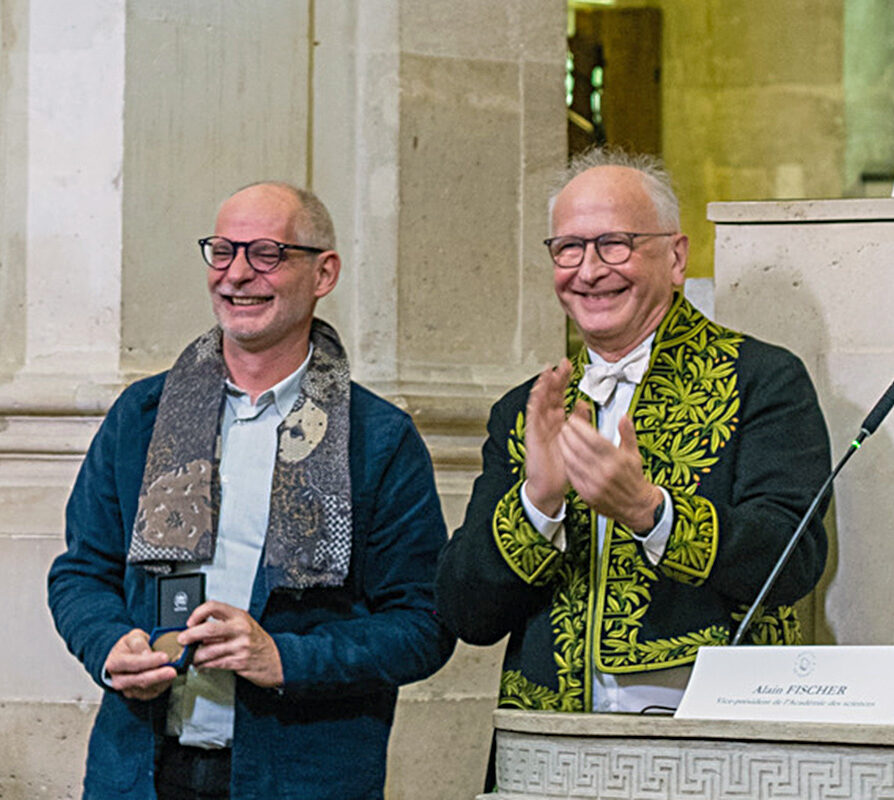Jean-Philippe Pin: a head full of glutamate
Jean-Philippe Pin, Director of Research at Montpellier'sInstitut de Génomique Fonctionnelle (IGF), won this year's Lamonica award for his career in molecular pharmacology, which has opened up new therapeutic avenues for the treatment of neurological and psychiatric diseases.

In a few months' time, Jean-Philippe Pin will be celebrating his fortieth anniversary at Montpellier'sInstitut de Génomique Fonctionnelle (IGF). " I've been working on glutamate receptors for forty years," laughs the CNRS research director. Listening to him talk about his work, his loyalty to his subject of study becomes clearer. Testing the role of this major neurotransmitter opens the door to the complexity of brain regulation, with possible therapeutic avenues for the treatment of nervous system disorders such as schizophrenia or neurodegenerative diseases. And let's face it, Jean-Philippe Pin doesn't need to prove himself any more. He was awarded the prestigious Lamonica Prize for Neurology in 2022, eleven years after receiving the CNRS Silver Medal.
When asked about his career, Jean-Philippe Pin doesn't start with his awards, but rather with his beginnings. As a master's student in Montpellier, he joined Joël Bockaert's laboratory at the Centre de pharmacologie-endocrinologie, which later became theIGF. The young researcher immersed himself in the study of the mechanism of action of glutamate, whose major role as a neurotransmitter was little-known at the time. " The scientific community had no idea that this simple amino acid could be the most important neurotransmitter, since its receptors are found on 80% of synapses ", he explains. After participating in the 1985 discovery of G protein-coupled glutamate receptors - summarized by the laborious acronym mGluR - the scientist joined the CNRS in 1988. He then headed for the United States for a post-doctorate at the Salk Institute in California, about which he laconically remarks: "I see trains go by ". In other words, he took part in the race to sequence the mGluR receptor genes, but other teams discovered the eight genes encoding the eight known receptors before him.
The Arpege technology platform
A good loser, Jean-Philippe Pin became interested in deciphering their activation mechanisms. With the aim of discovering new ways of acting in the treatment of neurological and psychiatric diseases. Indeed, these receptors are proving to be interesting drug targets. In the Molecular Pharmacology department he set up at the IGF in 2003, Jean-Philippe Pin is developing new high-throughput analysis techniques dedicated to the study of this class of receptors. Easy to say, but you still need to find the financial resources. Collaborations with pharmaceutical laboratories have opened up a number of avenues, but after a few years they have come to nothing, due to a lack of convincing clinical results.
In the end, salvation came from other collaborations. Jean-Philippe Pin created the Arpege technology platform, open to researchers wishing to test G protein-coupled receptors. " This pooling of resources gives us access to engineers and equipment comparable to those in industry ", says the researcher. A partnership with the biotech company Cis-Bio, which supplies the laboratories with screening kits, also gives his team access to technologies and tools " inaccessible to our academic competitors ". To complete the scientific and technological triptych, a Chinese post-doctoral fellow enabled the IGF to set up a collaboration with a laboratory in Wuhan in 2004. " All the research on atomic structure is carried out over there, using equipment such as electron microscopes that is inaccessible to our teams here ", stresses the researcher, who holds weekly video meetings with his colleagues in the Chinese city that has become known as the cradle of covid-19.
Medicine of the future
But of course, research is not just a question of means. Among his sound scientific intuitions, a new hypothesis about glutamate receptors proved to be right: receptors are made of two parts that are not necessarily identical. This hitherto unknown heterogeneity is now " recognized by the scientific community ", says the man who says he likes to " challenge dogma in science ". His other current challenge is to rely on antibodies rather than chemical molecules for treatment. With his team, he is testing the action of antibodies on the famous mGluRs in the brain and their effects on schizophrenia.
This time, he's one step ahead, imagining the medicine of the future by working on treatments based on photo-controllable molecules. The idea? Trigger the activity of a molecule by means of a diode, enabling its action to be precisely localized. " It ' s a major challenge to be able to target an area of the brain, because the same molecule can have different effects depending on whether it acts in the cerebellum or the globus pallidus, for example ", explains Jean-Philippe Pin. This year's Lamonica prize recognizes these prospects for new therapeutic agents, and brings in 100,000 euros for the IGF and 10,000 for the man who was its director between 2011 and 2020.
